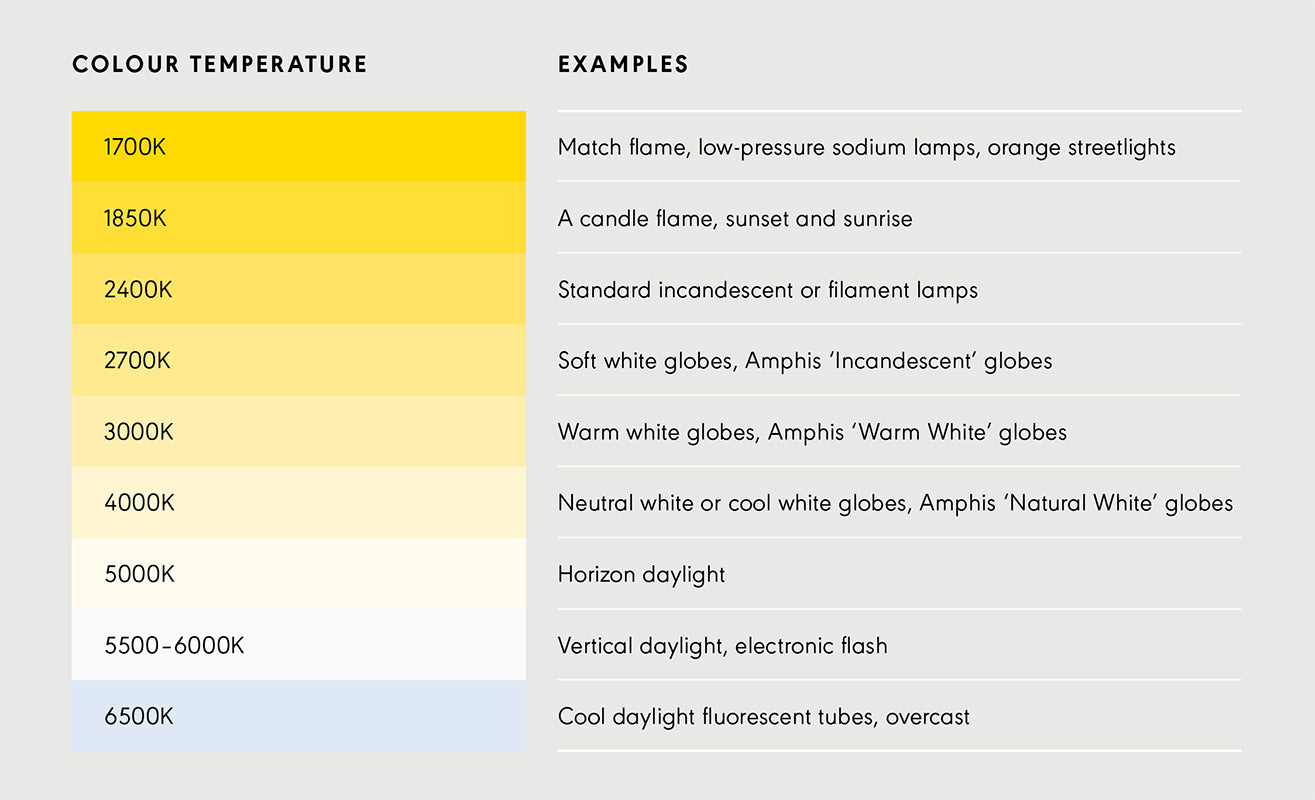Colour temperature is not related to the heat of the bulb, but rather to the colour of visible light produced. It’s a spectrum of how ‘warm’ (yellow) a light is, to how ‘cool’ (blue) it is, and is measured in degrees Kelvin (K).
The table shows examples of light sources and their colour temperatures. At the lower end of the scale, light appears orange, such as a candle flame at 1850K. Moving up the scale, light becomes more white, as with readily-available bulbs of 3000K and 4000K. At the high end of the scale, light sources take on a blue tinge, like on an overcast day.
Colour temperature is a powerful tool when used correctly and can have a massive impact on the overall feel and functionality of a room. Whether you’re aiming for a warm, cosy atmosphere or a bright and fresh appearance, let’s explore how to achieve the desired lighting balance in your home.
2700 - 3500K: Warm white
Amphis ‘Warm White’ is 3000K. This warm lighting style, with its yellow or orange tone, is loved for its ability to create a cosy and welcoming atmosphere in any space, reminiscent of a crackling fireplace or the flicker of candlelight. With its inviting glow, this colour temperature is perfect for unwinding after a long day and providing an intimate environment.
Where should I use warm white light in my home?
The dining area is a great place to utilise warm colour temperature as it creates an inviting and familiar atmosphere. The bedroom is another key place for warm lighting as it helps promote tranquillity, a calm body and a deeper sleep. If you appreciate warm white lighting, consider integrating it throughout the living room, kitchen, and bathroom as well.
What are the benefits?
Health-wise, warm white lighting is known to enhance mood thanks to its relaxing tone. Design-wise, using a warm colour temperature for accent lighting can complement various design styles and add a welcoming touch to your favourite architectural elements.
Left: Warm downlights invite guests into this living room. Middle: Falun exterior wall light with its 3000K glow. Right: The Ganon ceiling light is ideal for bedrooms as its 2700K colour temperature is calming.
3500K - 4500K: Natural white
Amphis ‘Natural White’ is 4000K. This colour temperature closely mirrors the unfiltered glow of natural sunlight and finds its application in a wide array of settings, spanning from residential to busy commercial spaces. Its versatility is particularly beneficial for task lighting in many areas of the home, or rooms devoid of direct natural light.
Where should I use warm white light in my home?
As the most neutral range of colour temperature, natural white light is well-suited for a variety of areas. Whether it’s the kitchen, bathroom, study, or garage, this colour temperature works effectively for both task lighting and ambient lighting, depending on your preference.
What are the benefits?
Natural white lighting is neither too warm nor too cold, making it a reliable choice for illuminating your home. It has the ability to promote balance, stability, neutrality, and create a sense of calm and consistency in your living space.
Left: Natural white globes work well for task lighting. Middle: The Zulla pendant lamp in 4000K colour temperature. Right: This walk-in wardrobe has natural white downlights, which are ideal for seeing the true colour of the clothing.
5000K and up: Cool white
Renowned for its crisp blue to white tinge, cool white lighting is commonly found in commercial spaces such as warehouses, offices and specialty spaces.
Where should I use cool white in my home?
Cool white lighting can often feel too clinical and harsh in residential spaces, where a softer atmosphere is desired. There has been much discussion about the effects of blue light on people. It is important to note with Amphis products that the lower the degrees Kelvin, the less blue light that is being emitted. Therefore, for the home, we recommend sticking between our warm white (3000K) to natural white (4000K) range.
What are the benefits?
Cool white lighting promotes the feeling of alertness and enhances productivity, making it ideal for areas where tasks require focus and attention.
For more information about how colour temperature may affect your space,
reach out to one of our team members.



